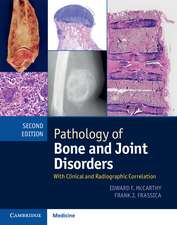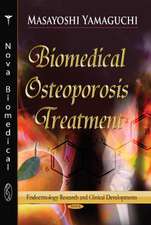Spinal Muscular Atrophy: Disease Mechanisms and Therapy
Editat de Charlotte J Sumner, Sergey Paushkin, Chien-Ping Koen Limba Engleză Hardback – 11 noi 2016
This book provides a comprehensive accounting of recent advances in basic and clinical research that covers SMA clinical features and standards of care, multifaceted aspects of SMN protein functions and SMA disease pathology, various animal models, and biomarkers, as well as current therapeutic development.
This title is ideal for graduate students/postdocs and principal investigators who are already in the SMA field and need to keep updated on recent findings and approaches, and for those who are new to, or would like to join, the field. Likewise, users will find an excellent source of reading for biotech/pharma scientists, clinical researchers, and practitioners, regulators, and patients and their advocacy organizations. Furthermore, this book is a handy reference for researchers and clinicians who may want to apply the research strategies and therapeutic approaches in SMA to other rare diseases.
- Provides comprehensive, up-to-date reviews by leading investigators on diverse topics of SMA, including clinical features and patient care, SMN genetics and protein functions, animal models, disease pathology and mechanisms, biomarkers, current therapeutic development, and the role of non-profit organizations in therapeutic development
- Written to bridge multiple disciplines and promote better communications among basic scientists, clinical researchers, and health care providers on the latest developments in SMA
- Includes outstanding questions and perspectives for future investigations and key references for additional detailed study
Preț: 740.76 lei
Preț vechi: 853.91 lei
-13% Nou
Puncte Express: 1111
Preț estimativ în valută:
141.76€ • 146.45$ • 117.98£
141.76€ • 146.45$ • 117.98£
Carte tipărită la comandă
Livrare economică 18 martie-01 aprilie
Preluare comenzi: 021 569.72.76
Specificații
ISBN-13: 9780128036853
ISBN-10: 0128036850
Pagini: 506
Dimensiuni: 216 x 276 x 48 mm
Greutate: 1.63 kg
Editura: ELSEVIER SCIENCE
ISBN-10: 0128036850
Pagini: 506
Dimensiuni: 216 x 276 x 48 mm
Greutate: 1.63 kg
Editura: ELSEVIER SCIENCE
Public țintă
Neuroscientists, biomedical researchers, grad students, postdocs, academic/biotech researchers, cliniciansCuprins
Section I. Clinical Features and Diagnosis of SMA
1. Spinal Muscular Atrophy: 125 Years Later and on the Verge of a Cure
2. Developmental Aspects and Pathological Findings in Spinal Muscular Atrophy
3. Standard of Care for Spinal Muscular Atrophy
4. Strategy for the Molecular Testing of Spinal Muscular Atrophy
Section II. Cellular and Molecular Mechanisms of the Disease
5. Transcriptional and Splicing Regulation of Spinal Muscular Atrophy Genes
6. The Function of Survival Motor Neuron Complex and Its Role in Spinal Muscular Atrophy Pathogenesis
7. RNA-Processing Dysfunction in Spinal Muscular Atrophy
8. Axonal and Neuromuscular Junction Pathology in Spinal Muscular Atrophy
9. Motor Circuit Dysfunction in Spinal Muscular Atrophy
10. Contributions of Different Cell Types to Spinal Muscular Atrophy Pathogenesis
11. Temporal Requirements for the Survival Motor Neuron Protein
12. Spinal Muscular Atrophy Disease Modifiers
Section III. Cell and Animal SMA Models
13. Cell Culture Models of Spinal Muscular Atrophy
14. Nonmammalian Animal Models of Spinal Muscular Atrophy
15. Mammalian Models of Spinal Muscular Atrophy
Section IV. Therapeutic Development
16. Spinal Muscular Atrophy Therapeutics Development
17. Small Molecule Approaches to Upregulate SMN Expression From the SMN2 Locus
18. Antisense-Oligonucleotide Modulation of SMN2 Pre-mRNA Splicing
19. Gene Transfer in Spinal Muscular Atrophy
20. Neuroprotection As a Therapeutic Approach for Spinal Muscular Atrophy
21. Skeletal Muscle in Spinal Muscular Atrophy As an Opportunity for Therapeutic Intervention
22. Addressing Cell Therapy for Spinal Muscular Atrophy: Open Issues and Future Perspectives
Section V. Clinical Research
23. Spinal Muscular Atrophy Motor Functional Scales and Measures of Pulmonary Function
24. Development and Testing of Biomarkers in Spinal Muscular Atrophy
25. Natural History of Spinal Muscular Atrophy
26. Spinal Muscular Atrophy Clinical Trials: Lessons Learned
1. Spinal Muscular Atrophy: 125 Years Later and on the Verge of a Cure
2. Developmental Aspects and Pathological Findings in Spinal Muscular Atrophy
3. Standard of Care for Spinal Muscular Atrophy
4. Strategy for the Molecular Testing of Spinal Muscular Atrophy
Section II. Cellular and Molecular Mechanisms of the Disease
5. Transcriptional and Splicing Regulation of Spinal Muscular Atrophy Genes
6. The Function of Survival Motor Neuron Complex and Its Role in Spinal Muscular Atrophy Pathogenesis
7. RNA-Processing Dysfunction in Spinal Muscular Atrophy
8. Axonal and Neuromuscular Junction Pathology in Spinal Muscular Atrophy
9. Motor Circuit Dysfunction in Spinal Muscular Atrophy
10. Contributions of Different Cell Types to Spinal Muscular Atrophy Pathogenesis
11. Temporal Requirements for the Survival Motor Neuron Protein
12. Spinal Muscular Atrophy Disease Modifiers
Section III. Cell and Animal SMA Models
13. Cell Culture Models of Spinal Muscular Atrophy
14. Nonmammalian Animal Models of Spinal Muscular Atrophy
15. Mammalian Models of Spinal Muscular Atrophy
Section IV. Therapeutic Development
16. Spinal Muscular Atrophy Therapeutics Development
17. Small Molecule Approaches to Upregulate SMN Expression From the SMN2 Locus
18. Antisense-Oligonucleotide Modulation of SMN2 Pre-mRNA Splicing
19. Gene Transfer in Spinal Muscular Atrophy
20. Neuroprotection As a Therapeutic Approach for Spinal Muscular Atrophy
21. Skeletal Muscle in Spinal Muscular Atrophy As an Opportunity for Therapeutic Intervention
22. Addressing Cell Therapy for Spinal Muscular Atrophy: Open Issues and Future Perspectives
Section V. Clinical Research
23. Spinal Muscular Atrophy Motor Functional Scales and Measures of Pulmonary Function
24. Development and Testing of Biomarkers in Spinal Muscular Atrophy
25. Natural History of Spinal Muscular Atrophy
26. Spinal Muscular Atrophy Clinical Trials: Lessons Learned
Recenzii
"This comprehensive, state-of-the-art textbook, covering all aspects of SMA, is very timely and should provide a springboard for further efforts and advances in the future." --Victor Dubowitz, M.D., Ph.D., Emeritus Professor of Paediatrics, University of London, London, UK
"This book is written by experts who contribute to major progress in the fields of SMA from the clinical features, molecular mechanisms, animal models, therapeutic developments to clinical trials. I have no doubt that this book will become an indispensable resource for clinicians and scientists having the goal to cure SMA." -- Judith Melki, M.D., Ph.D., Professor of Medical Genetics, Medicine Faculty, University of Paris 11; Inserm and University of Paris 11, U-788, Kremlin-Bicetre Hospital, Paris, France
"Now there is an important book which chronicles the many paths and diverse approaches taken to understand SMA and develop therapies, a clear strength of the SMA field has been the extensive sharing of data that has advanced the field rapidly." --Arthur H.M. Burghes, Ph.D., Professor, Department of Biological Chemistry and Pharmacology, College of Medicine, The Ohio State University, Columbus, OH, USA
"We have come a long way on the path to therapeutics development for SMA, and safe and effective treatment is now within reach. This book comes at an opportune time to take stock of where we are on this path and to see what the future holds." -- Kenneth H. Fischbeck, M.D., NIH Distinguished Investigator, Neurogenetics Branch, National Institute of Neurological Disorders and Stroke, National Institutes of Health, Bethesda, MD, USA
"This book is written by experts who contribute to major progress in the fields of SMA from the clinical features, molecular mechanisms, animal models, therapeutic developments to clinical trials. I have no doubt that this book will become an indispensable resource for clinicians and scientists having the goal to cure SMA." -- Judith Melki, M.D., Ph.D., Professor of Medical Genetics, Medicine Faculty, University of Paris 11; Inserm and University of Paris 11, U-788, Kremlin-Bicetre Hospital, Paris, France
"Now there is an important book which chronicles the many paths and diverse approaches taken to understand SMA and develop therapies, a clear strength of the SMA field has been the extensive sharing of data that has advanced the field rapidly." --Arthur H.M. Burghes, Ph.D., Professor, Department of Biological Chemistry and Pharmacology, College of Medicine, The Ohio State University, Columbus, OH, USA
"We have come a long way on the path to therapeutics development for SMA, and safe and effective treatment is now within reach. This book comes at an opportune time to take stock of where we are on this path and to see what the future holds." -- Kenneth H. Fischbeck, M.D., NIH Distinguished Investigator, Neurogenetics Branch, National Institute of Neurological Disorders and Stroke, National Institutes of Health, Bethesda, MD, USA










